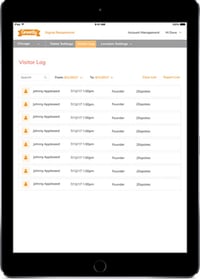Paper Versus Digital Visitor Logbooks | Greetly
While paper beats electronic in some areas, your visitor logbook should be digital. See how a digital visitor log can make your workplace more...
Insight into why most workplaces are replacing pen-and-paper visitors logbooks (or no data collection at all) with cloud-based visitor logs.
Does your organization keep a record of the visitors who come and go throughout your workday? A visitor logbook has many benefits that your organization can use to its advantage.
While some might consider a log “just another inconvenience,” when used properly, a visitor log can help to protect both your organization and your guests and to provide other valuable information.
Whether you choose paper or digital visitor logs is a matter of preference, though one has obvious advantages over the other. We’ll outline how the two differ with regard to the benefits your organization can reap.
Numerous visitors pass through the average workplace on any given day. Customers, clients, delivery personnel, family, job candidates and more – they all stop in for various reasons and may stay for only a few minutes, or for most of a day.
Some workplaces pay zero attention to registering guests. As an example, small offices may not have any visitor logs at all. Some retail establishments with hundreds of customers often don’t bother to have any forms of registration for their customers; although more sophisticated retailers like mobile phone stores and service-oriented salons do register guests, and others track you through passive means.
Other organizations are on the opposite end of the spectrum and have strict policies about registering every guest. K-12 schools, for instance, are often very careful to have all guests check-in upon arrival, and usually require they wear a visitor badge during their stay on site. Some hospitals, factories, and offices are the same. Some corporate workplaces even require delivery personnel to check-in. Still, other workplaces are somewhere in the middle, requiring some, but not all, guests to register.
Why would some businesses choose to keep a visitor log when it adds an extra layer to their work? Why do some not bother with it at all?
The fact is that organizations and their reasons for keeping a visitor log are as varied as organizations themselves. However, there are a few overarching benefits that come with keeping accurate visitor records that make the extra time and trouble worth it to organizations. The primary benefits include:
Visitor logs are part of an effective visitor management system, and visitor management often starts with access control. Access control is the fundamental concept in security where a person has to have the proper credentials to access something, whether parts of a computer system or database or an area with restricted access in a facility.
To be truly effective, organizations control the visitor registration process by requiring all visitors to enter through one specific entrance. This further prevents unauthorized access to the building by visitors who have not been vetted in any way. (One entrance is also more user-friendly – guests know exactly where they are supposed to be.)
The idea behind visitor logs and visitor sign-in apps is that guests are required to check in before they enter a building. This is about knowing who is in the building and sometimes about controlling who can go where.
For instance, some schools not only require guests to sign in at the front office, but they may also be required to provide and/or leave some form of identification, like a driver’s license, with the office when going farther into the building.
In large office buildings, delivery people may not be allowed to move past the front lobby, and instead must wait in the lobby until the person they are delivering to can meet them. (Having a visitor log-in system that automatically contacts the person in question can be incredibly helpful in such situations.) In other buildings, the delivery person is allowed to go through the building to the contact, but only after logging in and receiving the appropriate permissions.
The requirement of checking in creates heightened security in both tangible and intangible ways.

Keeping track of who is on the premises at all times can become especially vital in times of emergency. Unfortunately, the people most unfamiliar with the building who aren’t normally there are those most likely to be lost, left behind, and unaccounted for if the worst were to come to pass.
Let’s imagine a devastating earthquake were to hit a building and sections of it collapsed. Firefighters and emergency personnel have arrived to put out fires and to engage in rescue efforts to pull survivors from the wreckage. Or there is a fire, active shooter, or factory chemical spill. What happens next? In these scenarios, having a record of visitors in hand can be the difference between life and death.
In some organizations, an automatic emergency notification will go to all employees via their work phones and/or mobile phones. A digital visitor logbook containing contact information may also be able to automatically contact visitors in the building to provide them with how to respond.
If it seems all the employees and people in the building have been evacuated, how can anyone be sure?
If visitors are required to both check in and check out, emergency personnel can be given the log when accounting for those who have escaped a building and those who have not. If all employees have escaped and been counted, but a visitor or two are not present, emergency personnel knows they still have people to locate. They will also know that the person or people in question are not familiar with the building and may be in a strange location.
Visitor logs can provide other important information, depending on the log itself. If the log contains the visitor’s name and who they were meeting, it might provide clues to the part of the building the visitor was in. If, for instance, a fire started near the accounting offices, and several accounting staffers have not yet exited the building, a visitor who was meeting an accounting staffer might be trapped in the same area.
In addition, if the log contains phone information for the visitors, emergency personnel may be able to use that information. If they call the number, they may learn:
All these factors make a visitor logbook an important tool in the emergency preparedness toolbox.

While security is quite easily the most important reason to have a visitor management system and a visitor logbook, data analytics might be the more glamorous reason.
Data science is fast emerging as an in-demand skill for organizations of all types. Businesses around the world are paying top dollar for data scientists who can use their skills to analyze large data sets, with the results helping organizations strategize everything from marketing to product development to how to arrange the desks in the building.
Visitor logbooks provide an array of data about the comings and goings of guests in the building. Depending on the type of organization in question, this information can be a gold mine of knowledge.
Since data can be analyzed in so many ways, it is hard to say exactly how useful a visitor data set is to an individual company. Here are some examples organizations might consider exploring with their visitor logbooks.
These are just a few pieces of information that might prove useful when taking advantage of a visitor logbook.

While nearly all of the benefits explained in the previous sections can be gained by having either a paper or a digital, cloud-based logbook, digital logbooks hold a clear advantage over paper. They make reaping the benefits of visitor logging described so much easier and more efficient.
The primary advantages paper logbooks have are cost and ease. All you need are a few pieces of paper in a three-ring binder and a pen. Guests walk in, write down their information, and move on. But that is really where the advantages end.
When it comes to security, paper logbooks cannot guard the data privacy of your guests the way a cloud-based logbook can. Any guest or employee could stop by and see names and contact information listed on the paper log. And that is assuming that your guests take the time to fill in all the required contact information. A digital system can require guests to include a phone number and email address information, something that is much easier to skip when writing on paper.
Cloud-based logbooks automatically store important information about guest arrivals and departures. If the need arises to search the logs for a particular time period or name – let’s say a theft occurred between 10 a.m. and 2 p.m. last Tuesday, or a regular vendor is suspected of a crime – an electronic log can retrieve the data far quicker than an employee can go to a file cabinet and riffle through pages. With paper logs, a name is especially hard to retrieve. Unless the information has been retyped or scanned into a database of some sort, finding a particular name over the course of several weeks or months requires an employee to spend valuable time poring over the logs looking for the name.
The same issue holds true for data analytics. If the information is all contained in paper logs, the ability to analyze the data is greatly hampered. It requires scanning or retyping the information that a digital log would already have neatly parsed.
And lastly, in the case of an emergency, nothing can beat a digital log, especially one that is stored in the cloud. If a facility is on fire or is otherwise too dangerous for people to be in, having access to the log of visitors from offsite is especially important. While a paper log may be destroyed or inaccessible in such a situation, a digital logbook provides this useful information through an internet connection.
Almost every workplace will benefit from having guests sign in at a central place. Offices, retail shops, manufacturing plants, and more will see an increase in security, emergency preparedness, and data gathering provided by a visitor log can be invaluable. Benefits range from visitor and employee safety to analytics to building your organization's digital community.
What may feel like a small inconvenience may, in fact, protect the company from crime, provide incredibly useful information for business purposes, and even save someone’s life.
While paper beats electronic in some areas, your visitor logbook should be digital. See how a digital visitor log can make your workplace more...
Visitor management is a vital component of your workplace's efficiency and security.
Visitors are an essential part of achieving your goals. And a visitor management system can lead to greater productivity and happier employees.